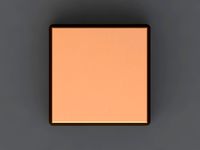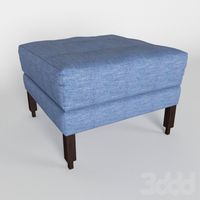Thingiverse

Triangle to or from Square Transformation, Dudeney's Dissection by lgbu
by Thingiverse
Last crawled date: 3 years, 1 month ago
Equilateral Triangle to/from Square, Dudeney's Dissection
The large models can be used as a pencil holder or organizer. Square or triangle? You choose what you like. It is fun to go back and forth-- very satisfying like a puzzle.
An equilateral triangle can be beautifully dissected into four pieces and rearranged into a square (Dudeney, 1902/1907; Steinhaus, 1950/1969), where there is a minor mathematical error with no physical implications. More interestingly, the pieces can be taped together and looped around between a triangle and a square. Mathematically, if the side length of the equilateral triangle is s, then the side length of the corresponding square is 3^(1/4) s/2 . In the design process, we use this fact, two midpoints, and two perpendicular lines (see Figure for Design).
To make it playful, I tried two designs: (1) Connected dissections for TPU flexible filaments, which demonstrate the idea well but are not perfect due to the twists and tension at the connections. One can start from a triangle or square; both are included. (2) Loose dissections which can be taped or used separate pieces.
Among the Files
Two models for TPU flexible filaments based on an equilateral triangle of side length 60mm.
A small loose square model (40mm x 40 mm) with a height of 10mm.
A large loose square model (100 mm x 100 mm) with a height of 45mm.
A large loose square model (100 mm x 100 mm) with a height of 90 mm.
Reference
Dudeney, H. (1907). The Canterbury puzzles. Available at https://bestforpuzzles.com/bits/canterbury-puzzles/index.html
Steinhaus, H. (1950/1969). Mathematical snapshots (3rd ed.). New York, NY: Oxford University Press.
https://mathworld.wolfram.com/HaberdashersProblem.html
The large models can be used as a pencil holder or organizer. Square or triangle? You choose what you like. It is fun to go back and forth-- very satisfying like a puzzle.
An equilateral triangle can be beautifully dissected into four pieces and rearranged into a square (Dudeney, 1902/1907; Steinhaus, 1950/1969), where there is a minor mathematical error with no physical implications. More interestingly, the pieces can be taped together and looped around between a triangle and a square. Mathematically, if the side length of the equilateral triangle is s, then the side length of the corresponding square is 3^(1/4) s/2 . In the design process, we use this fact, two midpoints, and two perpendicular lines (see Figure for Design).
To make it playful, I tried two designs: (1) Connected dissections for TPU flexible filaments, which demonstrate the idea well but are not perfect due to the twists and tension at the connections. One can start from a triangle or square; both are included. (2) Loose dissections which can be taped or used separate pieces.
Among the Files
Two models for TPU flexible filaments based on an equilateral triangle of side length 60mm.
A small loose square model (40mm x 40 mm) with a height of 10mm.
A large loose square model (100 mm x 100 mm) with a height of 45mm.
A large loose square model (100 mm x 100 mm) with a height of 90 mm.
Reference
Dudeney, H. (1907). The Canterbury puzzles. Available at https://bestforpuzzles.com/bits/canterbury-puzzles/index.html
Steinhaus, H. (1950/1969). Mathematical snapshots (3rd ed.). New York, NY: Oxford University Press.
https://mathworld.wolfram.com/HaberdashersProblem.html
Similar models
thingiverse
free

Triangle-Square Dudeney's Dissection/Transformation, Hinged by lgbu
...rk, ny: oxford university press.
https://mathworld.wolfram.com/haberdashersproblem.html
https://www.thingiverse.com/thing:4815886
cults
free

Triangle to Hexagon Dissections, Math
...bridge, uk: cambridge university press.
http://demonstrations.wolfram.com/hingeddissectionofanequilateraltriangleintotwohexagons/
thingiverse
free

Triangle to Hexagon Dissections, Math by lgbu
...idge, uk: cambridge university press.
http://demonstrations.wolfram.com/hingeddissectionofanequilateraltriangleintotwohexagons/
.
3dwarehouse
free

Dudeney's Dissection
...rrect rotation direction. key square side measurements are shown. the other key measurements are half points on the square sides.
thingiverse
free

Dissections of the Greek Cross
...of pieces and a fourth dissection, "d_pieces", makes four dissimilar pieces related to the symmetric dissection. a small box...
thingiverse
free

Pythagorean Theorem on Hinges with Equilateral Triangles by lgbu
...fine! however, we don’t have to use squares. any similar 2d shapes constructed on the three sides of the...
grabcad
free

Dudeney's Dissection (Triangle to Square)
...just in case you wanted to 3d print it.
modelled with solidworks 2016
rendered with photoview 360
gifs made with photoscape v3.7
thingiverse
free

Pythagoras on Hinges, Dissection Models for the Pythagorean Theorem by lgbu
...hypotenuse, 40-100- hypotenuse)
references
https://www.cut-the-knot.org/pythagoras/
https://www.cs.purdue.edu/homes/gnf/book.html
thingiverse
free

Perfect Square Puzzle 112x112 by WeltderGeduldspiele
...://www.thingiverse.com/thing:4883224.
for general information about perfect rectangles and squares, see http://www.squaring.net/.
thingiverse
free

Tetrahedron, Puzzle, Triangular Pyramid, Dissection, Four Pentahedra by lgbu
...ord university press. (p. 202). the authors gave a net but did not say how to slice a tetrahedron for the four congruent pieces.
Dudeney
thingiverse
free

Hinged Dissection (Dudeney dissection) by clark4ea
...here is a link to our class blog about hinged dissections: https://geekhaus.com/math103_fall2017/2017/10/05/rhombic-dodecahedron/
thingiverse
free

Triangle-Square Dudeney's Dissection/Transformation, Hinged by lgbu
...rk, ny: oxford university press.
https://mathworld.wolfram.com/haberdashersproblem.html
https://www.thingiverse.com/thing:4815886
thingiverse
free

Pentomino (Tetris) Puzzle by Henry Dudeney by danellinwood
...7&keywords=aio+robotics+pla+filament+1.75mm&linkcode=sl1&tag=dellinwo-20&linkid=7c380586a7127d39933722cad3817193)
thingiverse
free

A Greek Cross Puzzle by pmoews
...greek cross puzzle by pmoews thingiverse two of henry dudeney#39;s greek cross puzzles have been combined to create this...
thingiverse
free

Container with a Puzzle Lid
...3 secure digital cards.it is based on one of dudeney#39;s puzzles - "the dovetailed block" . http://amusementsinmathematics.com/aim/puzzlecategory.htm#x_424_the_dovetailed_block it looks...
thingiverse
free

Dissections of the Greek Cross
...can be assembled into a square. they appear in dudeney#39;s 1917 book "amusements in mathematics" which has a section...
thingiverse
free

Hinged Triangle-Square by mathgrrl
...triangle and back again. the model is based on dudeney#39;s famous hinged dissection known as the "haberdasher's puzzle". for...
grabcad
free

Dudeney Puzzle
...minor things.
https://www.youtube.com/watch?v=erxriiuilec
article about henry dudeney
http://fr.wikipedia.org/wiki/henry_dudeney
grabcad
free

Dudeney's Haberdasher puzzle
...dudeney's haberdasher puzzle
grabcad
the parts *link* nicely after being 3d printed ..the typeface is victorian
Lgbu
thingiverse
free

Pythagoras Tree 345 by lgbu
...ntentionally designed to overlap to a little bit for stability. easy to design in 123d design using the basic idea of similarity.
thingiverse
free

Chinese Lantern by lgbu
...the size needed. do use a raft for printing.
please note that the stl file is pretty big, around 100 mb because of the structure.
thingiverse
free

Tetrahedron, Triangular Pyramid Puzzle by lgbu
...giverse so i decided to make one. you need to print 4 copies of the same piece to make a triangular pyramid. great for all ages!
thingiverse
free

Pythagoras Tree (1:1:Sqrt2) by lgbu
...ap a little bit. the structure is very easy to design in 123d design using the basic idea of similarity. yes, this is a fractal.
thingiverse
free

Golden Curve/Spiral by lgbu
...ometric representations. the curve, of course, has interesting properties that are worthwhile for a k-12 steam class. have fun!
thingiverse
free

Hyperboloid Container / Caddy by lgbu
...s 45 degrees. the height of the resulting hyperboloid is about 74 mm. it is made of 18 or 36 copies of two symmetrical rulings.
thingiverse
free

Ceiling Hooks by lgbu
...asurement.
among the files are four ceiling hooks of various widths, a length of 70 mm, and a depth of 12 mm. the slot is 3mm.
thingiverse
free

Parallelogram Area Formula, Why? by lgbu
.... this can be further used to find the areas of many other shapes such as trapezoids, triangles, and even circles. have fun!
thingiverse
free

Hexagonal Chain Mail Interlocking Patterns by lgbu
...e as it is, it shows the value and fun of 3d design and printing. the 123d file is included so you could tweak it as you please.
thingiverse
free

Simple Tessellation Pattern by lgbu
...e included. it measures about 96 mm x 50 mm and 3.6 mm thick. six copies will be a good starting point (see pictures posted).
Dissection
turbosquid
$300

rudbeckia dissected
...d model rudbeckia dissected for download as max, obj, and fbx on turbosquid: 3d models for games, architecture, videos. (1182363)
turbosquid
$460

flowerbed of rudbeckia dissected
...rbed of rudbeckia dissected for download as max, obj, and fbx on turbosquid: 3d models for games, architecture, videos. (1182360)
turbosquid
$200

Human Heart Dissection Detailed
...uman heart dissection for download as ma, obj, fbx, and blend on turbosquid: 3d models for games, architecture, videos. (1361664)
turbosquid
$150

Human Skin Detailed Dissection
...n detailed dissection for download as ma, obj, fbx, and blend on turbosquid: 3d models for games, architecture, videos. (1366704)
turbosquid
$190

Male and Female Reproductive System Dissection
...ive system dissection for download as ma, obj, fbx, and blend on turbosquid: 3d models for games, architecture, videos. (1371212)
3d_export
$179

Anatomy Dissection laboratory
...nimum of polygons -scene fully configured and ready to render. -no photoshop on the preview -scene for 3ds max 2012 and v-ray 2.0
3d_export
$249

Human Anatomy Dissection Laboratory
...e made carefully with a minimum of polygons > -scene fully configured and ready to render. > -no photoshop on the preview.
3d_export
$15

Autopsy Table Roll-In with Down-Draft-System
...table roll-in with down-draft-system 3dexport autopsy table roll-in with dissection table professional autopsy tables with integrated exhaust system serve...
3d_export
$144

kaws flayed companion
...ave mirror modifiers and share the same uv coordinates (2500 verts each)<br>ready to visualization in cycles render engine.
3d_export
$97

kaws flayed lowpoly pbr
...maps. title is rendered in eevee, product pictures are rendered in cycles. ready for visualization in cycles/eevee render engine.
Transformation
archibase_planet
free

Transformer
...r high-voltage transformer voltage transformer
high voltage transformer n300614 - 3d model (*.3ds) for exterior 3d visualization.
archibase_planet
free

Transformer
...transformer electric transformer converter transducer
transformer n121015 - 3d model (*.gsm+*.3ds) for exterior 3d visualization.
archibase_planet
free

Transformer
...sformer
archibase planet
transformer toy child play
transformer n140408 - 3d model (*.gsm+*.3ds) for interior 3d visualization.
3d_export
$50

Transformer
...transformer
3dexport
3d bltnder
turbosquid
$12

Transformer
...free 3d model transformer for download as blend, fbx, and obj on turbosquid: 3d models for games, architecture, videos. (1614605)
archive3d
free

Transformer 3D Model
...ansformer unit
transformer unit n250816 - 3d model (*.gsm+*.3ds) for exterior 3d visualization.
turbosquid
$79

transformer
... available on turbo squid, the world's leading provider of digital 3d models for visualization, films, television, and games.
turbosquid
$60

Transformer
... available on turbo squid, the world's leading provider of digital 3d models for visualization, films, television, and games.
turbosquid
$10

Transformer
... available on turbo squid, the world's leading provider of digital 3d models for visualization, films, television, and games.
turbosquid
$6

transformation
... available on turbo squid, the world's leading provider of digital 3d models for visualization, films, television, and games.
Triangle
3ddd
$1

Тумба Triangle
...тумба triangle
3ddd
тумба , triangle
тумба в современном стиле triangle
3ddd
$1

Triangled posters
...triangled posters
3ddd
постер
triangled posters collection
3ddd
$1

Carpet Triangle
...carpet triangle
3ddd
ковер
carpet triangle, ковер , узоры, треугольник
design_connected
free

Triangle Table
...triangle table
designconnected
free 3d model of triangle table by atelier areti designed by kerschbaumer, gwendolyn.
turbosquid
$2

triangle sign
...quid
royalty free 3d model triangle sign for download as fbx on turbosquid: 3d models for games, architecture, videos. (1421072)
turbosquid
$1

Triangle Signal
...id
royalty free 3d model triangle signal for download as fbx on turbosquid: 3d models for games, architecture, videos. (1162930)
3d_export
$5

impossible triangle
... and materials.<br>https://www.shutterstock.com/video/clip-1057067141-3d-animation-impossible-triangle-that-assembled-cubes
3d_export
$5

triangle house
...triangle house
3dexport
living in a house that is happy
turbosquid
$35

Triangle Hanger
... available on turbo squid, the world's leading provider of digital 3d models for visualization, films, television, and games.
turbosquid
$15

Dinner Triangle
... available on turbo squid, the world's leading provider of digital 3d models for visualization, films, television, and games.
Square
turbosquid
free

Square
...squid
free 3d model square for download as max, obj, and stl on turbosquid: 3d models for games, architecture, videos. (1510355)
3d_export
$5

square table
...square table
3dexport
square table
turbosquid
$12

Square
...oyalty free 3d model square for download as max, obj, and fbx on turbosquid: 3d models for games, architecture, videos. (1294110)
3ddd
$1

Square Ottoman
...square ottoman
3ddd
пуф
square ottoman
turbosquid
$25

The Square
...ee 3d model the square for download as mat, max, dxf, and obj on turbosquid: 3d models for games, architecture, videos. (1186399)
3d_export
$65

square
...square
3dexport
simple rendering of the scene file
3d_export
$65

square
...square
3dexport
simple rendering of the scene file
3d_export
$65

square
...square
3dexport
simple rendering of the scene file
3d_export
$65

square
...square
3dexport
simple rendering of the scene file
3d_export
$65

square
...square
3dexport
simple rendering of the scene file
